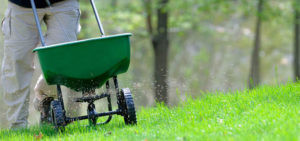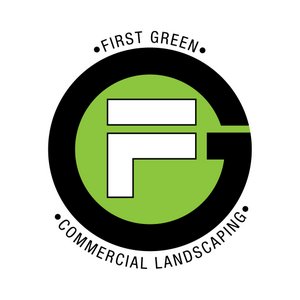 The end of summer doesn’t mean the end of lawn care. Take these simple steps with your grass now and you’ll have a head start on a healthy lawn for next spring.
The end of summer doesn’t mean the end of lawn care. Take these simple steps with your grass now and you’ll have a head start on a healthy lawn for next spring.
Fall Mowing
Continue to water and mow your lawn, as needed, throughout the fall. Then as the season draws to a close, drop the mower’s blade to its lowest setting for the last two cuttings of the year. Change your mowing pattern every other mow if possible. Mow two strips around the perimeter of turf and then mow in straight lines perpendicular to this. A good mower will mow wet turf and pick up clippings better. Consider a mulching mower. With a mulching mower the clippings are returned to the soil and allow much of the water and nutrients to return to the soil.
Edging
Try to edge your lawn every other mow. Either a gas powered edger or a weed eater held vertically will do the job. A good edge to the turf keeps the lawn looking great and separates the turf from the bed areas.
Weed Control
Your turf will be healthy with the proper mowing tips. When weeds do crop up they should be treated with a contact, selective herbicide or by hand removal. You may find if you spend time each mowing pulling up the weeds manually, it may take less time than actually buying and applying a herbicide, not to mention the environmental benefit. Fertilizer with weed controls deposit the herbicide throughout the whole lawn, thus putting more herbicide into the environment than is needed to treat weeds.
Moss Control
Factors that favor moss development include wet, humid conditions and compacted soils with thin turf. Moss is more common in shady areas with infertile, acidic soils and excessive thatch. You may want to consider removing the lawn and replacing it with shade tolerant plants. When you have mosses in your lawn apply liquid Iron. After the moss has died, rake it out. Overseed bare areas and cover with a sandy soil or peat moss. Fall is a great time to reseed this area.
Watering
As a general rule, turf may need 3-5 watering per week in a dry season. Overwatering can be as harmful as not watering because turf roots need oxygen to survive. If turf is in standing water you should cut back the watering. Watering should not be necessary during the wet winter months unless there is a long dry spell.
Fertilization
Kentucky bluegrass and perennial ryegrass lawns in sun should receive 1 to 4 pounds per 1000 square feet of actual nitrogen every year. Make your fall application to the lawn about October 15, while grass still is green and while 2-3 weeks remain before the ground freezes. Fertilize only when below 80 degrees.
Aeration
The benefits of aeration include allowing more oxygen into the root zone and reducing compaction which allows microorganisms to naturally reduce thatch. Germination depends upon seed-to-soil contact therefore aeration, which pulls cores of soil from the lawn so that water, air and nutrients have easier access to turfgrass roots is very beneficial to the lawn. The resulting holes in the soil give the seedlings favorable conditions to grow and mature, assuming they receive frequent light watering and are fertilized properly.
Overseeding
Of course, cooler fall weather arrives earlier the further north you go, so the timing of fall overseeding depends more upon daily temperatures than it does on the calendar. A good rule of thumb is to overseed early enough in either late summer or early fall to give the turfgrass seed time to germinate and the resulting seedlings time to mature to the point where they can survive the winter and begin growing again when spring arrives.
Thatching
Thatch is dead grass layer between the roots and foliage of grass. If your lawn has a spongy feel, thatch is probably needed. In regions that experience frost and snow, dethatch warm-season grasses in late spring to early summer – well before heat arrives and the lawn’s water needs are high. Use of a thatcher will remove thatch and also healthy grass, leaving the turf fairly bare. Overseeding and top dressing will help fill in the turf.
Topdressing
Top dressing is the process of applying compost, soil, or sand over the surface of your lawn. It has been performed on golf courses since the sport was invented in Scotland, but has only recently become popular on other lawns. Aerating and overseeding just prior to topdressing will improve the benefits of topdressing.
Mole Control
As you walk onto your carefully manicured lawn, an unsightly raised pattern of grass and broken earth catches your attention. Surprise you have Moles. Believe it or not, if you’ve got moles it’s because you’ve got something good going on underground in your lawn. Earthworms! “Earthworms are the No. 1 source of food for moles. As long as there is an abundance of earthworms in a lawn, it is a target for moles. But, since earthworms are beneficial to a lawn, you should never try to eradicate them. Moles are best controlled with traps. Another method of control is used kitty litter in and around mole hills. This can force moles out as they sense the presence of a predator.
Is your property not receiving the attention it deserves? Are you tired of overpaying for subpar service? First Green Landscaping provides the best value for professional lawn care and landscaping services in the Cincinnati / Northern Kentucky area. No property is too big or too small for First Green Landscaping.
Contact us (859-292‐8556) today for a free consultation!
—
 About First Green Commercial Landscaping
About First Green Commercial Landscaping
First Green Commercial Landscaping is a locally owned leading provider of lawn care and landscaping services in the Cincinnati / Northern Kentucky area. We provide superior customer service and strive to build long term business relationships with our clients.
- Lawn Care
- Landscape Maintenance
- Snow Removal
>> Learn More

 About First Green Commercial Landscaping
About First Green Commercial Landscaping